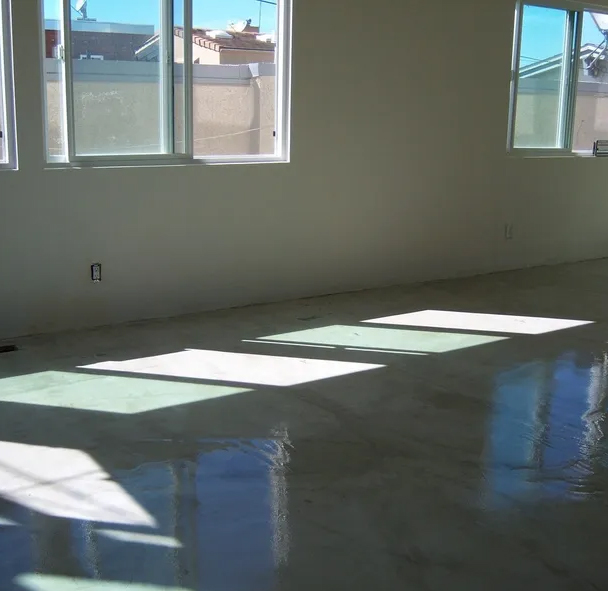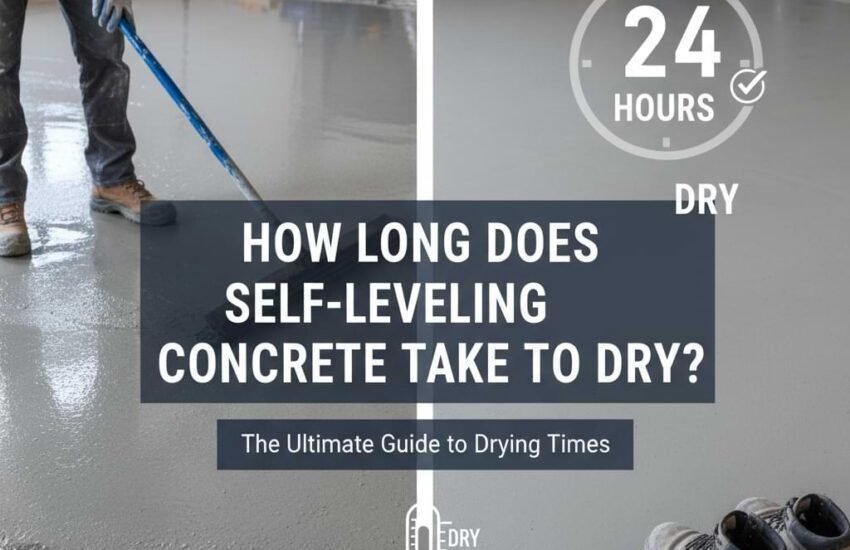If you’re planning a concrete floor repair or upgrade, one of the first questions you’ll ask is: how long does self leveling concrete take to dry? Typically, self leveling concrete takes 24 to 48 hours to dry for light foot traffic, and up to 7 days to fully cure before installing flooring or heavy materials. However, this timeline can vary depending on the product type, thickness, and environmental conditions.
Understanding Self Leveling Concrete
Self leveling concrete is a specialized cement-based compound designed to create smooth, even surfaces over existing subfloors. Unlike traditional concrete, it flows easily and “self-levels,” filling dips, cracks, and imperfections. This makes it ideal for concrete floor repair, basement renovations, or preparing a surface for polished concrete in Orange County homes and commercial spaces.
Professionals and DIYers alike appreciate self leveling concrete because it’s durable, easy to apply, and dries relatively quickly compared to traditional concrete mixes. But to get the best results, timing and conditions matter.
Typical Drying Times
Here’s a quick breakdown of how long self leveling concrete takes to dry under standard conditions:
| Condition | Drying Time | Notes |
|---|---|---|
| Light foot traffic | 4 to 8 hours | Depends on brand and temperature |
| Tile or flooring installation | 24 to 48 hours | Ensure moisture content is below 5% |
| Full cure (ready for sealing or polishing) | 7 days | Allow complete hydration and strength gain |
These times assume average room temperature (70°F / 21°C) and low humidity. Cooler or wetter environments may double the drying time.
Step-by-Step: How to Ensure Proper Drying
If you’re applying self leveling concrete, here’s how to make sure it dries evenly and on schedule:
- Prepare the Subfloor
Clean and remove all dust, debris, and oil. A well-prepared surface ensures proper bonding and prevents moisture entrapment. - Prime the Surface
Use a manufacturer-recommended primer to seal porous concrete and prevent air bubbles during pouring. - Mix Correctly
Follow mixing ratios precisely. Too much water can weaken the mix and extend drying time. - Pour Evenly and Quickly
Work fast, as most self leveling compounds begin to set within 15–30 minutes. Use a gauge rake or smoother for even distribution. - Control the Environment
Maintain stable temperature and humidity levels. Use fans for air circulation but avoid direct airflow over wet concrete, which can cause cracking. - Check Moisture Levels Before Installing Flooring
Even if the surface feels dry, internal moisture can still cause problems. Use a moisture meter before laying vinyl, tile, or hardwood.
Quick Takeaways
- Light foot traffic: 4–8 hours
- Install flooring: after 24–48 hours
- Fully cured: ~7 days
- Warm, dry environments = faster drying
- Cool, humid areas = slower curing
Factors That Affect Drying Time
1. Thickness of the Pour
A thin layer (1/8 inch) may dry within 4 hours, while a thick 1-inch pour can take over 48 hours.
2. Product Type
Rapid-setting compounds (like Ardex or Mapei) are engineered to dry in as little as 2–3 hours, while standard mixes take longer.
3. Temperature and Humidity
High humidity slows evaporation, while low temperatures delay hydration. Ideally, apply self leveling concrete in 60–80°F conditions.
4. Substrate Condition
If the subfloor is damp or not properly sealed, moisture will migrate up into the new layer, prolonging drying time.
5. Air Circulation
Gentle airflow helps the top layer set evenly, but direct heat or drafts can cause cracks and uneven curing.

Professional Insight: What the Experts Do
Professionals performing concrete floor repair or preparing for polished concrete in Orange County always account for drying variability. Here’s what experienced contractors recommend:
- Use a rapid-set mix for small jobs or tight timelines.
- Always perform a moisture test before applying sealers or flooring adhesives.
- Never rush installation — most failures occur when flooring is applied before full cure.
- In humid coastal areas (like Orange County), use dehumidifiers or fans to maintain consistent conditions.
By combining the right materials, environment, and patience, you’ll ensure a smooth, long-lasting finish.
When Can You Walk, Work, and Install Flooring?
- Walk on it: After 4 to 8 hours (check product label).
- Install tile, vinyl, or carpet: After 24 to 48 hours, once moisture levels are safe.
- Polish or seal: Wait 7 days for a fully hardened surface.
If you’re planning a polished concrete surface, curing is especially important. Polishing too early can pull moisture to the surface, creating hazy or inconsistent finishes.
Maintenance and Longevity
Once cured, self leveling concrete can last for decades with minimal upkeep. Protect it by:
- Keeping moisture levels stable
- Using high-quality sealers
- Avoiding heavy loads during early curing
- Cleaning spills promptly
A properly installed and cured surface not only looks professional but also enhances durability and property value.
When to Call a Professional
While self leveling concrete is marketed as DIY-friendly, getting perfect results requires precision. If your project involves:
- Large surface areas
- Deep cracks or damaged subfloors
- Moisture-prone basements
- Or you want a polished concrete finish
It’s best to hire a contractor who specializes in self leveling concrete and concrete floor repair to ensure flawless results.
FAQs About Self Leveling Concrete Drying Times
Q: Can I speed up the drying process?
Yes — by improving air circulation, maintaining warm temperatures, and using rapid-set products. Avoid applying direct heat, as it can cause cracks.
Q: What happens if I install flooring too soon?
Trapped moisture can cause bubbling, adhesive failure, or mold growth. Always test moisture before installation.
Q: Can self leveling concrete dry overnight?
Some quick-set formulas allow light traffic after just 6 hours, but full curing still takes several days.
Q: Is sealing necessary after it dries?
Yes, sealing helps protect the surface from moisture, stains, and wear, especially if it’s used as a finished floor.
Q: How do I know it’s fully cured?
The color will lighten as it cures, but the best way to confirm is with a moisture test or by following manufacturer’s timelines.
Proper timing is the key to success when working with self leveling concrete. By understanding how long it takes to dry — and what factors influence that process — you can achieve a smooth, durable surface that’s ready for any finish, from tile to polished concrete. Whether you’re tackling a small concrete floor repair or refinishing a full space, patience and preparation make all the difference.
If you’re looking for self-levelling concrete near you, contact our team for a free estimate today.



